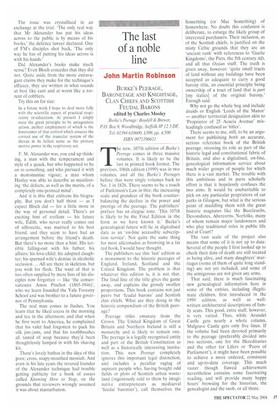The last of a noble line
John Martin Robinson
BURKE'S PEERAGE, BARONETAGE AND KNIGHTAGE, CLAN CHIEFS AND SCOTTISH FEUDAL BARONS edited by Charles Mosley Burke's Peerage / Boydell & Brewer, P.O. Box 9, Woodbridge, Suffolk IP 123 DF, Tel: 01394 610600, £399, pp. 4,500 ISBN 0971196621 The new, 107th edition of Burke's Peerage comes in three massive volumes. It is likely to be the
last in printed book format. The previous, 106th edition (1999) was in two volumes, and all the Burke's Peerages before that were single volumes back to No. 1 in 1826. There seems to be a touch of Parkinson's Law in this; the increasing scale and grandeur of the book counterbalancing the decline in the power and prestige of the peerage. The publishers' preface has an elegiac tone. 'This 107th is likely to be the Final Edition in the form as we have known it.' Burke's genealogical future will lie in digitalised data as an 'on-line accessible subscription service'. Not quite the same thing for most aficionados as browsing in a fat red book, I would have thought. The publishers see this 'last' edition as a monument to the historic peerages of England, Ireland, Scotland and the United Kingdom. The problem is that whatever this edition is, it is not that. The final line of the title gives the game away, and explains the grossly swollen proportions. This book contains not just peers but 'feudal barons' and Scottish clan chiefs. What are they doing in the historic compendium of the British peerage? Peerage titles emanate from the Crown. The United Kingdom of Great Britain and Northern Ireland is still a monarchy and is likely to remain one. The peerage is a legally recognised entity and part of the British Constitution as well as a historically interesting institution. This new Peerage completely ignores this important legal distinction, and includes a peculiar ragtag of aspirant people who, having bought odd fields or plots of Scottish urban wasteland (ingeniously sold to them by imaginative entrepreneurs as mediaeval 'feudal baronies"), call themselves the Something (or Mac Something) of Somewhere. No doubt this confusion is deliberate, to enlarge the likely group of interested purchasers. Their inclusion, as of the Scottish chiefs, is justified on the misty Celtic grounds that they are an 'ancient rank' with references to 'Gaelic Kingdoms', the Picts, the 5th century AD, and all that Ossian stuff. The truth is given away, however: 'quite small tracts of land without any buildings have been accepted as adequate to carry a good barony title, an essential principle being ownership of a tract of land that is part [my italics] of the original barony.' Enough said. Why not go the whole hog and include druids or English 'Lords of the Manor' — another territorial designation akin to 'Proprietor of 25 Acacia Avenue' misleadingly confused as 'titles'.
There seems to me, still, to be an argument for publishing both an accurate, serious reference book of the British peerage, stressing its role as part of the historic legal and constitutional fabric of Britain, and also a digitalised, on-line, genealogical information service about much wider groups of people for which there is a vast market. The trouble with this ambitious and in parts scholarly effort is that it hopelessly confuses the two aims. It would be uncharitable to pick on any particular proprietors of car parks in Glasgow, but what is the serious point of muddling them with the great historic magnates like the Buccleuchs, Devonshires, Abercorns, Norfolks. many of whom remain major landowners and who play traditional roles in public life and at Court?
The vast scale of the project also means that some of it is not up to date. Several of the people I first looked up to check their date of death are still treated as being alive, and many daughters' marriages (some of them of quite long standing) are not yet included, and some of the armigerous are not given any arms. That said, there is much fascinating new genealogical information here in some of the entries, including illegitimate children, first introduced in the 1999 edition, as well as wellwritten architectural descriptions of family seats. This good, extra stuff, however, is very varied. Thus, while Arundel Castle gets nearly a whole column, Mulgrave Castle gets only five lines, If the volume had been devoted primarily to the peerage (preferably divided into two sections, one for the Hereditaries and the other for Lifers or 'Peers of Parliament'), it might have been possible to achieve a more ordered, consistent and up-to-date coverage. This much vaster though flawed achievement nevertheless contains some fascinating reading, and will provide many happy hours' browsing for the historian, the genealogist and the snob, or all three.


















































































 Previous page
Previous page